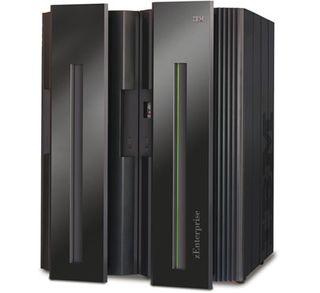IBM Reveals World's Fastest Microprocessor: z196
Sorry, this new 5.2 GHz processor wasn't designed for your desktop.

Tuesday during the Hot Chips 2010 conference, IBM revealed more details surrounding its 5.2 GHz microprocessor, the z196. The chip isn't designed for consumer consumption, but rather for the company's Z-series of mainframes. Its cost is estimated to be in the hundreds of thousands--perhaps even over a million bucks.
During the conference, IBM said that the processor is based on CISC architecture and contains 1.4 billion transistors on a 512 sq. mm chip fabricated on 45-nm PD SOI technology. The chip provides 64KB L1 instruction cache, 128KB L1 data cache, and 1.5MB private L2 cache per core. It also uses a pair of co-processors for cryptographic operations.
Additionally, a 4-node system uses 19.5MB of SRAM for L1 private cache, 144MB for L2 private cache, 576MB of eDRAM for L3 cache, and 768MB of eDRAM for a level-4 cache.
IBM engineer Brian Curran said Tuesday that the z196 uses 1079 different instructions. 75 of these instructions can be used by millicode (IBM's term for instructions internally executed by the processor) only, and 219 can be executed by millicode. An additional 24 instructions are "conditionally executed" by millicode.
Curran said that the z196 processor will be available sometime in September.
Stay on the Cutting Edge
Join the experts who read Tom's Hardware for the inside track on enthusiast PC tech news — and have for over 25 years. We'll send breaking news and in-depth reviews of CPUs, GPUs, AI, maker hardware and more straight to your inbox.
-
dalethepcman You shouldn't publish articles about "The Matrix" the humans will begin asking questionsReply -
demn z196Reply
The mainframe cores are based on the z196 chip, a 5.2 GHz quad-core out-of-order CISC-based z/Architecture processor. They are the highest clock speed microprocessors available at the introduction date and, at least at introduction, the fastest CPUs in the world. These cores can run a variety of operating systems in any combination, including z/OS, z/VM, Linux on System z, z/VSE, and z/TPF.
A z196 node is a two rack system; the "A frame" consisting of the Central Processing Complex, cooling, none or one I/O drawer or up to two drawers and power supply and the "Z frame" with two system Support Elements and up to four I/O drawers or up to two I/O cages.
Comes in five models, named after the number of processors: M15, M32, M49, M66 and M80.
Up to 96 cores segmented to up to 80 processor units, up to 14 system assist cores and 2 spares.
Up to 3 TB of RAIM (Redundant Array of Independent Memory), i.e 3.75 TB of RAM where 750 GB is used for parity redundancy. This function allows the system to recover from entire memory channel failures in addition to chipkills.
Nodes can be either water or air cooled.
Compatible with the previous z9 EC and z10 EC mainframes providing a clear upgrade path.
(c) Wikipedia -
mikem_90 Big Blue Boasts big business brain for biotech? But biome brooding becons big-time bits too!Reply -
I'd ask "but can it play Crysis," but the answer is obvious. In fact, it can probably orchestrate an actual alien invasion of Earth. Does this kind of tech actually reach later consumer processors, or is this just an extreme of current tech that will be expected to be superseded by the time consumer computing demands reach this level? Or is this entirely the wrong question?Reply
Most Popular






